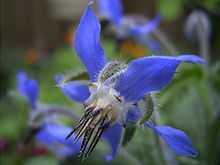Borago
| Borago | |
|---|---|
 | |
| Borago officinalis flowers | |
| Scientific classification | |
| Kingdom: | Plantae |
| (unranked): | Angiosperms |
| (unranked): | Eudicots |
| (unranked): | Asterids |
| Order: | (unplaced) |
| Family: | Boraginaceae |
| Subfamily: | Boraginoideae |
| Genus: | Borago |
| Species | |
|
Borago longifolia Poir. | |
Borago, or borage, is a genus of five species[1] of herbs native to the Mediterranean, with one species, Borago officinalis cultivated and naturalized throughout the world.
Uses
Borago offinalis is used medicinally, in companion planting, in cooking and as an oilseed. Cooked stalks are sometimes eaten as a vegetable. The large, hairy leaves taste mildly of cucumber, and star-shaped purple-blue flower are prized for their flavour. The leaves are often added to teas and salads, and the flowers have been added to wine (Borage has had a reputation to give one courage since Roman times). The flowers are highly attractive to bees. The hairs covering the plant are said to repel herbivores.
Features
Borages are annual or perennial herbaceous plants with alternate leaves and long-stalked flowers. The inflorescences are branched scorpioid cymes, i.e. subsequent flowers are oriented in a curve, as in the tail of the scorpion. Borages are annuals or perennials.
The flowers are star-shaped wheel or bell-shaped, nectar is dispersed through a cone-shaped structure. They are pollinated by bees. The corolla is blue, pink or white. Corollas are rotate with five petals. The corolla tube is short or nonexistent. Throat scales are short, hairless and emarginate, i.e. with a nick or notch at the apex, standing out from the crown.
The stamens are inserted near the base of the corolla. The anthers are mucronate, with long pointy appendages and upright. The stamens protrude through the throat scales to nearly the bottom of the crown. The stamens are at the top of a long narrow appendage. The appendix is a long narrow apex. Style whole filiform to the base ovarium . The style does not extend beyond the scales of the throat and a capitate stigma. Four Nuculas with a thick ring-shaped collar at the base.
The fruits are small obovate achenes. Seeds are dispersed by ants.
Distribution
The species of this genus are found in cultivated and rocky areas through the southwestern Mediterranean. The genus is a monophyletic group and very close genetically to the sister group Symphytum. Four of the five species are found only in northwest Africa, Corsica, Sardinia and the Tuscan Archipelago. Only Borago officinalis is widely cultivated and has become naturalized through much of the temperate world (e.g. Argentina, Canada, Chile, United States, Mexico, Paraguay). Borago officinalis was once thought to be native to Syria, but it is probably of North African origin, where there are other Borago species. It is often grown as ornamental.
Species
The genus comprises five species in two subgenera:
Subgenus Borago is characterized by erect herbaceous wheel-shaped flowers, blue, sometimes white
- Borago officinalis cultivated throughout the world, native to North Africa.
- Borago trabutii endemic to the High Atlas and the Anti-Atlas, Morocco.
- Borago longifolia endemic to northern Algeria and Tunisia.
Subgenus Buglossites is prostrate and have bright, bell-shaped flowers
- Borago pygmaea sometimes cultivated, native to Corsica, Sardinia and the island of Capraia.
- Borago morisiana endemic to the island of San Pietro in southwestern Sardinia.
Books
- Bennett, M. (2003) Pulmonarias & the Borage Family. B.T. Batsford, ISBN 0-7134-8732-1
References
- ↑ Selvi, Coppi & Bgazzi (2006). "Karyotype Variation, Evolution and Phylogeny in Borago (Boraginaceae), with Emphasis on Subgenus Buglossites in the Corso-Sardinian System". Annals of Botany 98 (4): 857–868. doi:10.1093/aob/mcl167. Retrieved November 7, 2012.
External links
| Wikimedia Commons has media related to Borago. |
| Wikispecies has information related to: Borago |